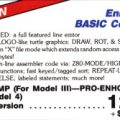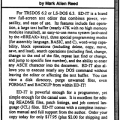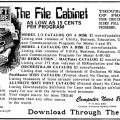PRO-WAM
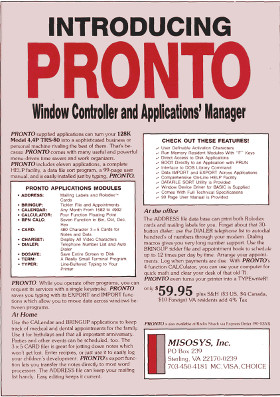
MISOSYS advertisement for PRO-NTO from the November 1985 issue of 80 Micro
PRO-WAM was one of the few programs to require a Model 4 expanded to a full 128K of memory. In my opinion, it was one of the best uses of the extra memory and one of my favorite Model 4 utilities.
Window Controller and Applications Manager
PRO-WAM was described in advertisements as a “Window Controller and Applications Manager.” It was inspired by the Borland program Sidekick, a terminate and stay resident personal information manager that was very popular at the time on the IBM PC.1 (PRO-WAM was also similar to Monte’s Window, written by Jim Stutsman, which was only available for Montezuma Micro CP/M.) Like Sidekick, PRO-WAM provided a set of simple, but useful, tools that could be popped up over a running program.
PRO-WAM could be activated at any time by pressing the CONTROL and P keys together. (That key combination could be easily changed.) After starting PRO-WAM, a user could launch any PRO-WAM application from a menu or by typing in the name. The applications included with PRO-WAM were:
- ADDRESS: a Rolodex-like address file
- BRINGUP: an appointment book and reminder file
- CALENDAR: a calendar capable of displaying any date from 1582 to 4902
- CALC: a floating point calculator
- RPNCALC: a reverse polish notation calculator
- CARD: a simple database for storing information as though on 3 by 5 index cards
- CHARSET: a program to display and export all characters in the character set
- DIALER: a telephone number database and telephone dialer
- TERM: a small terminal emulator
- TYPER: a utility to send lines of text to the printer
- DOSAVE: a utility to save the video display to disk
Users could customize applications in the menu, remove applications they didn’t use, or even add third-party applications. For those who wanted to write their own PRO-WAM applications, MISOSYS sold the $29.95 PRO-WAM Toolkit, which provided all the necessary information. There were many third-party PRO-WAM applications (sometimes known as Wammies) available on CompuServe and on bulletin board systems.
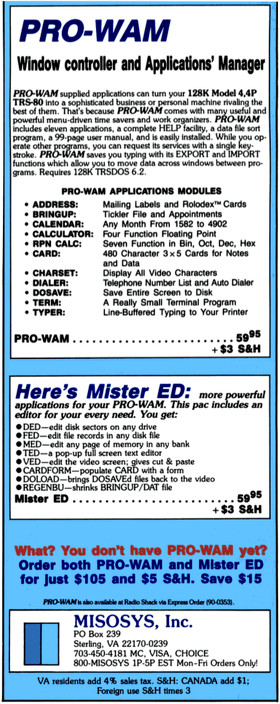
MISOSYS advertisement for PRO-WAM and Mister ED from the January 1987 issue of 80 Micro
Pronto from the Chemical Bank
PRO-WAM was originally named PRO-NTO when it was introduced in 1984 and used that name until 1986. In February 1986, MISOSYS received a complaint that PRO-NTO name infringed upon Chemical Bank’s trademark for their Pronto electronic banking service. Although it is hard to see much chance for confusion, MISOSYS changed the name of PRO-NTO to PRO-WAM in mid-1986.2 PRO-WAM, which stood for Window and Application Manager, became the much better known of the two names.
Mister ED
In fall of 1986, MISOSYS introduced an enhancement package for PRO-WAM called Mister ED. Mister ED cost $59.95 and added seven new PRO-WAM applications with the five main ones focused on editing:
- FED: a file editor
- DED: a disk editor
- MED: a memory editor
- VED: a video screen editor
- TED: a text editor with a 30K text buffer3
I always found the Mister ED tools, FED and MED in particular, to be very useful when programming.
PRO-WAM version 2
In Spring 1987, MISOSYS released PRO-WAM version 2. It was a major enhancement, adding full support for the extra memory provided by Model 4 memory expansion boards such as the XLR8er and the Alpha Technology Supermem, among many other features. It also added:
- PHRASE: a supercharged key-stroke-multiplier utility
- CARDXF: an enhanced version of CARD that supported up to ten cardfiles
- TODO: a customizable todo list
On July 1, 1987, the price of PRO-WAM increased to $74.95.
Compatibility
Because PRO-WAM was designed within the guidelines of Model 4 TRSDOS, it was compatible with almost all LS-DOS/TRSDOS 6 programs. Even applications such as DoubleDuty, which used extra memory to create two Model 4 environments, worked fine with PRO-WAM as long as the Model 4 had a third-party memory expansion large enough to accomodate both programs.
There were only a handful of applications that didn’t work properly with PRO-WAM. The main offenders were the word processors LeScript and SuperScripsit, which used their own keyboard routines and didn’t allow pasting from PRO-WAM. The SuperScripsit export problem was fixed by a clever filter written by Lynn R. Sherman in an article published in the Winter 1988 issue of The MISOSYS Quarterly.
PRO-WAM, along with almost all the remaining MISOSYS TRS-80 products, was discontinued after a closeout sale that ended on June 15, 1993.
-
According to Roy Soltoff, the working filename for the program that became PRO-WAM was “SK” (for Sidekick). ↩︎
-
Chemical Bank’s Pronto was one of the first electronic banking services and is an interesting story in its own right. Chemical Bank shut down Pronto in 1989, which means that MISOSYS PRO-NTO/PRO-WAM outlasted the Chemical Bank Pronto by almost four years. ↩︎
-
The TED/CMD text editor included with LS-DOS 6.3 was based on the Mister ED TED application, not the other way around. ↩︎

